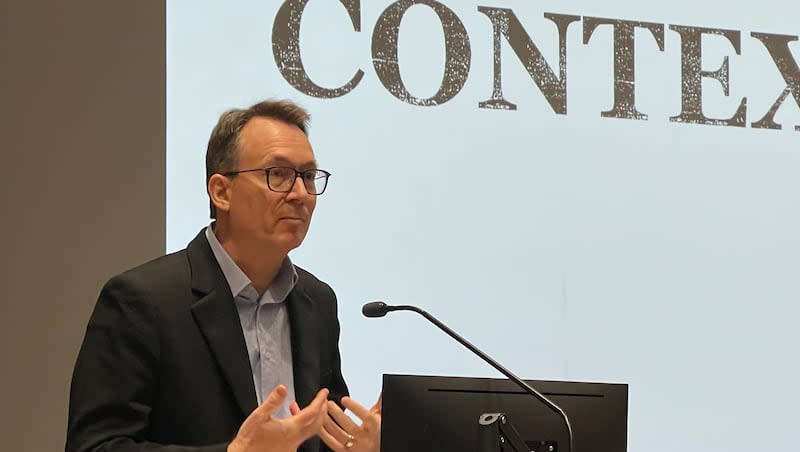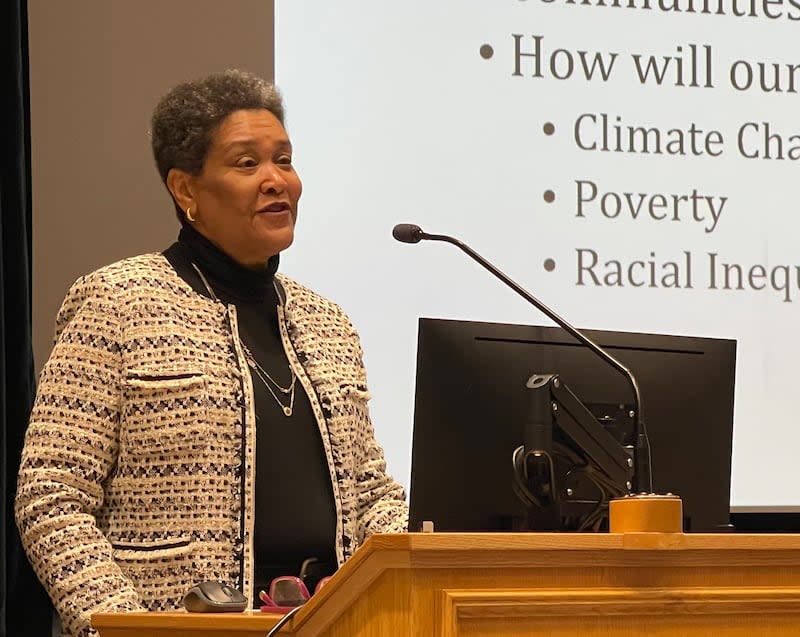BYU conference about the history of slavery in Utah seeks reconciliation

- Oops!Something went wrong.Please try again later.
- Oops!Something went wrong.Please try again later.
Scholars said a willingness to be uncomfortable with the nation’s history can be a key component to reconciliation during the 2024 BYU Slavery Project conference on the Brigham Young University campus.
They also pleaded for healing through education and understanding during the conference, which was titled “Truth and Reconciliation” and drew more than 200 people to the Varsity Theater.
BYU began a public campaign against racism in 2020, prompted by the chair of its board of education, President Russell M. Nelson, the leader of its sponsoring institution, The Church of Jesus Christ of Latter-day Saints.
President Nelson issued a joint statement with NAACP leaders in June 2020 that called for work to end systemic racism in education and elsewhere.
“We likewise call on government, business and educational leaders at every level to review processes, laws and organizational attitudes regarding racism and root them out once and for all,” they wrote.
A week later, BYU announced the formation of a committee on race and belonging that the following year issued recommendations to root out racism it found on campus. One of the 15 proposals the university has implemented so far was the creation of an Office of Belonging with a leader who is a member of the university president’s cabinet.
“We must recognize the reality of racism in society and condemn any ongoing racial prejudice,” BYU’s Vice President of Belonging Carl Hernandez said during the conference.
“Telling the truth and knowing and understanding the truth is important,” he told the Deseret News. “If those truths are uncomfortable, then we need to find a way to reconcile. That’s the gospel of Jesus Christ.”
The BYU Slavery Project began with a history professor in 2019. It studies the legacy of slavery in the United States during the time in which BYU was founded, history professor Matthew Mason said.
Clemson, Georgetown, Harvard, TCU, Virginia and dozens of other American universities have projects that examine slaveholding and the history of higher education.
Northwestern professor Leslie Harris was the conference’s keynote speaker. Co-author of the book “Slavery and the University: Histories and Legacies,” she said it is important to discuss the way in which slavery created economic advantages for some and economic depravity for others.
The book notes that American slavery and higher education began and matured simultaneously, which meant scholars and universities developed both proslavery and antislavery thought and discriminatory laws that persisted well beyond the Civil War.
“The histories of race on our campus are not just about symbolism,” she said. “They are rooted in the realities of our nation.” She also said that many “colleges and universities were founded and funded by money from slavery and the slave trade. Our institutions often sit on lands formerly occupied by Native peoples and in some cases are former slave plantations.”
Other presenters at the conference noted that one early benefactor of Brigham Young Academy, the predecessor to Brigham Young University, had owned four slaves. Another scholar presented a photo of students on campus in the 1950s using blackface, noting how racist attitudes prevalent in the United States influenced university life, including classroom instruction. Early lecture notes from James E. Talmage, a future Latter-day Saint apostle who attended Brigham Young Academy, show racist post-Civil War ideas about racial hierarchy and racial superiority were taught.

A national look at the history of racism
“In my estimation, it’s impossible to root out racism without examining its roots. And today I want to talk about its roots,” Paul Reeve, author of the Deseret Book title “Let’s Talk About Race and Priesthood” and chair of the University of Utah’s Mormon Studies program, said at the event.
In 1852, just under a decade before the Civil War, Utah’s Territorial Legislature passed a law to regulate enslavement in the territory. Reeve said the entire nation was “struggling with one central question — can human beings be held as property?” Northerners said no and believed the Declaration of Independence clearly declared slavery was wrong. Southerners said yes, human beings could be property, and they believed the Constitution protected their property rights.
Joseph Smith, whom Brigham Young succeeded as president of The Church of Jesus Christ of Latter-day Saints, reported in 1833 that he had received a revelation that slavery is immoral. That revelation contributed to the Missouri order to evict and exterminate the Latter-day Saints.
Joseph Smith also ran an abolitionist campaign for the U.S. presidency in 1844. Part of his platform was compensated emancipation, which would pay slave owners to release all slaves by 1850.
In April 1862, Congress passed — and Abraham Lincoln signed — the District of Columbia Compensated Emancipation Act. It freed slaves in the District of Columbia and compensated owners up to $300 for each freeperson. D.C. commissioners paid to grant freedom to 2,989 former slaves, according to a history page on the U.S. Senate website.
During the decades leading up to and through the Civil War, a popular idea throughout the United States was a centuries-old belief, unsupported by scriptural evidence, that God cursed Cain and his descendants with black skin after he murdered Abel.
Brigham Young successfully asked the Legislature to pass “An Act in Relation to Service,” which legalized slavery in the Utah territory. The law differed from Southern-style chattel slavery because it mandated education for slaves, prohibited buying and selling slaves without their consent, and stipulated that children of slaves were born free.
President Young referred to the “curse” during the debate.
Latter-day Saint leaders have disavowed the idea of a curse. In 2013, the church’s governing First Presidency and the Quorum of the Twelve Apostles released a landmark 2013 Gospel Topics essay titled “Race and the Priesthood.” “Today, the Church disavows the theories advanced in the past that black skin is a sign of divine disfavor or curse ... or that Blacks or people of any other race or ethnicity are inferior in any way to anyone else,” the essay says.
While slavery was rare among early Latter-day Saints in Utah, many early Latter-day Saint converts came from the northeast or England, and three slaves were in the first party of Mormon pioneers to arrive in the Salt Lake Valley in 1847.
At least 61,000 Latter-day Saint pioneers migrated to the state from 1847-68. U.S. Census data in 1850 and 1860 listed between 24 and 45 slaves. A total of about 100 Black people appear in reliable documents as being enslaved in Utah Territory before the 13th Amendment ended the practice for good in 1865, Reeve said.
Brigham Young helped legalize slavery in the Utah territory, and the historical record suggests he may have also been involved in facilitating the freedom of at least two formerly enslaved persons.
One was Green Flake, a member of that first 1847 pioneer company, and a man born enslaved to the Flake family of North Carolina.
According to the work of scholar Amy Tanner Thiriot, after a Flake family member moved from Utah, she sought to enlist Brigham Young in selling Green Flake for the financial benefit of the Flake family. Brigham Young, however, did not sell Green Flake and instead appears to have briefly purchased Green Flake’s labor. After the passing of Green’s former owner shortly after, Green Flake was free on the 1850 census. A relative recalled years later that “Green shed tears at the death of Brigham Young and helped dig his grave.”
“Once we come to terms with the truth of our history,” Reeve said, “we can then pivot to the redemptive work of reconciliation. We can begin to imagine what still could be.”
Reeve said he adopted the philosophy of Elder Steven E. Snow, the former Church Historian and Recorder, who said, “My view is that being open about our history solves a whole lot more problems than it creates.”
Latter-day Saint leaders model reconciliation
Today, church leaders approach racism with plainspokenness.
The church’s prophet, President Nelson, linked arms with the NAACP in 2018 and said the church and its leaders “strive to build bridges of cooperation rather than walls of segregation.”
“I grieve that our Black brothers and sisters the world over are enduring the pains of racism and prejudice,” he said in 2020. “Today, I call upon our members everywhere to lead out in abandoning attitudes and actions of prejudice. I plead with you to promote respect for all of God’s children.”
The historically Black Morehouse College awarded President Nelson its first Gandhi-King-Mandela Peace Prize in 2023 for his efforts.
President Dallin H. Oaks, first counselor in the First Presidency, acknowledged in 2018 that the church’s past restriction on Black people holding the priesthood and receiving temple blessings caused pain and suffering.
A champion of the Constitution, President Oaks also has said it originally included the “birth defect of slavery” and that the 13th Amendment abolishing slavery was divinely inspired.
FamilySearch, a Latter-day Saint nonprofit that gathers and shares genealogical records, and education, announced last month that it will help build a free database of 10 million enslaved Africans with the genealogical society American Ancestors.
The work of truth and reconciliation
Today’s divisive political climate makes it inevitable that some will push back or even attack the idea of reviewing history’s impact on the present, several scholars said.
“Each movement towards new knowledge in these areas has invoked fear, if not backlash,” Harris said. “Why? Sometimes it’s very simple. We fear making a mistake. We fear doing the right thing, but doing it wrong. We fear change.”
Harris was a consultant on The New York Times’ controversial “1619 Project,” but the Times ignored her when she vigorously disagreed with reporters who asserted that slavery was a main reason for the American Revolution.
She said Friday it is difficult to know how to do the right thing and be safe.
“I would ask you as members of Brigham Young University to ask yourselves, is Brigham Young a place of deliberate engagement and constructive struggle? Is it a place where you are safe from harm but perhaps a little uncomfortable every now and then, as a sign of growth?
“These are foundational to our survival, writ large and writ small.”

